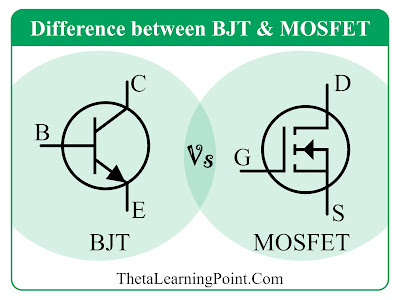In this article, we will explore all the important differences between BJT and MOSFET. The main difference between BJT and MOSFET is that BJT (Bipolar Junction Transistor) is a current-controlled device, while MOSFET (Metal-Oxide Semiconductor Field Effect Transistor) is a voltage-controlled device.
Before exploring the differences between BJT and MOSFET, let’s
first have an overview of their basics individually.
Introduction to Bipolar Junction Transistor (BJT)
BJT, Bipolar Junction Transistor, is a semiconductor device
used for switching and amplification in various electronic circuits. A BJT
typically consists of three terminals and two p-n junctions. It is constructed
by sandwiching a layer of p-type (or n-type) semiconductor material between two
layers of n-type (or p-type) semiconductor material.
The three semiconductor regions of a bipolar junction
transistor are named emitter, base, and collector. BJT is a type of
current-controlled device which means it utilizes an input current which controls
its output quantity.
Based on construction, BJTs are classified into two types
namely, NPN bipolar transistor and PNP bipolar transistor.
Bipolar junction transistors (BJTs) are used in a variety of
electronic devices, such as electronic switches, amplifiers, sensors, oscillators,
and more.
Introduction to Metal-Oxide Semiconductor Field Effect Transistor (MOSFET)
MOSFET, Metal-Oxide Semiconductor Field Effect Transistor,
is another type of transistor used for switching and power regulation in
electronic and power electronic circuits.
A MOSFET typically consists of three terminals namely
source, gate, and drain. It has a channel (n-type or p-type) for the flow of
charge carriers from source to drain. MOSFET is a type of voltage-controlled
device, as its output is controlled by the voltage applied at the gate
terminal.
MOSFETs are known for their faster switching speed, low
power consumption, and compact design. All these advantages make MOSFETs a
better choice for digital electronic circuits.
MOSFETs are widely used in power electronic devices like
UPS, inverters, automotive electronics, electric vehicles, digital ICs, and
more.
After getting insights into the basics of Bipolar Junction Transistors
(BJT) and Metal-Oxide Semiconductor Field Effect Transistors (MOSFET), let’s now
study their comparison.
Difference between MOSFET and BJT
The following table gives a list of all the significant
differences between MOSFET and BJT:
|
Key |
BJT |
MOSFET |
|
Acronym |
BJT is an acronym for Bipolar Junction Transistor. |
MOSFET is an acronym for Metal-Oxide Semiconductor Field Effect
Transistor. |
|
Terminals |
BJT has three terminals namely, Emitter, Base, and Collector. |
MOSFET has three terminals namely, Source, Gate, and Drain. |
|
Control quantity |
BJT is a current-controlled device. |
MOSFET is a voltage-controlled device. |
|
Device type |
BJT is a bipolar device, as it conducts current due to both electrons
and holes. |
MOSFET is a unipolar device, as it conducts current due to majority
charge carriers only. |
|
Input impedance |
BJT has low input impedance. |
MOSFET has high input impedance. |
|
Switching frequency |
BJT has a low switching frequency, typically of the order of kHz. |
MOSFET has a high switching frequency, typically of the order of MHz. |
|
Switching losses |
BJT has high switching losses. |
MOSFET has comparatively low switching losses. |
|
Conduction losses |
BJT has low conduction losses. |
MOSFET has comparatively high conduction losses. |
|
Power consumption |
BJT consumes more power. |
MOSFET consumes less power. |
|
Types |
BJTs are of two types namely, NPN bipolar transistor and PNP bipolar
transistor. |
MOSFETs are of two types namely, depletion-mode MOSFET (n-channel and
p-channel) and enhancement-mode MOSFET (n-channel and p-channel). |
|
Thermal noise |
BJT has high thermal noise. |
MOSFET has low thermal noise. |
|
Thermal stability |
BJT has less thermal stability. |
MOSFET has high thermal stability. |
|
Size |
BJT has a comparatively larger size. |
MOSFET has a more compact size than BJT. |
|
Gain bandwidth product |
BJT has a high gain-bandwidth product. |
MOSFET has a low gain-bandwidth product. |
|
Input-output relation |
BJT has a linear relationship between input and output. |
MOSFET has a non-linear relationship between input and output. |
|
Cost |
BJT is less expensive. |
MOSFET is more expensive than BJT. |
|
Applications |
BJT is mainly used in low-power applications and analog electronic circuits. |
MOSFET is mainly used in high-power applications and digital
electronic circuits. |
Hence, all these are the important differences between BJT
and MOSFET. Both BJT and MOSFET are two types of transistors used for switching
and amplification of electronic signals. However, they are completely different
from each other as illustrated in the above table.


.png)





0 Comments